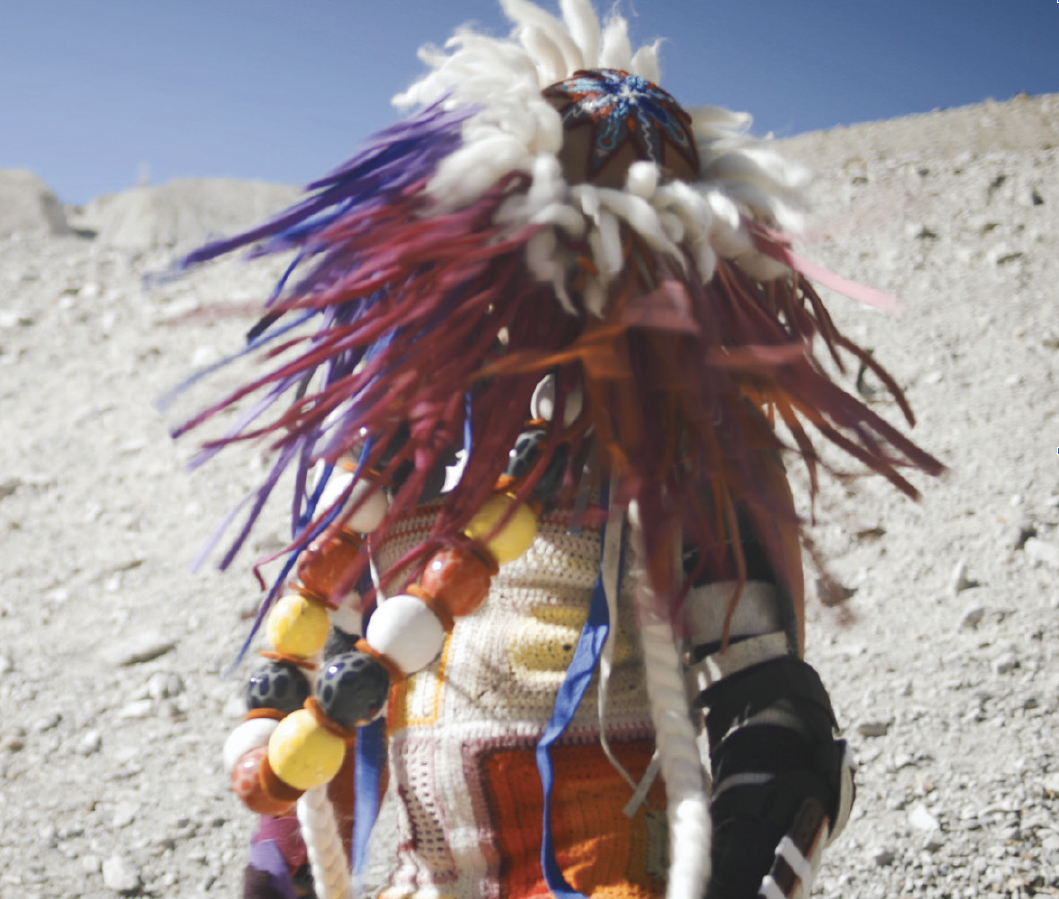Cannupa Hanska Luger:
We Live, from the Future Ancestral Technologies project, 2019Art direction, regalia design/construction, poetry and sound composition single channel video
courtesy of the artist
resources:
artist site
“Illuminating the Plight of Missing and Murdered Indigenous Women,” John Hanc, New York Times
“Drones and Snakes,” Jessica L. Horton, Art in America
“Q&A: The artist who made protesters’ mirrored shields says the ‘struggle porn’ media miss point of Standing Rock,” Carolina A. Miranda, Los Angeles Times
5 Plain Questions podcast feature:

Even in an era where many artists are stretching across disciplines, the radical, futuristic, and compassionate work of Cannupa Hanska Luger exists in its own jet stream, leaping between practices and stitching together multi-dimensional understandings of contemporary Indigeneity. Though his work often foregrounds large scale installations that can include a wide range of elements – ceramics, video, sound, fiber, steel, and repurposed materials – a central force of Luger’s practice combines performance with audience and community participation, drastically expanding the web of political and human impacts within a given piece.
A Mandan, Hidatsa, Arikara, and Lakota artist raised on the Standing Rock Sioux Reservation in North Dakota, his work first gained widespread attention in 2016 when, while on a residency at the Institute of American Indian Arts, he posted an instructional video for the making of mirror shields for the defense of water protectors in the midst of the Dakota Access Pipeline and their private security teams’ incursion into sovereign Native land at Standing Rock. As the video, and his MIRROR SHIELD project, gained support and visibility from individuals across the country looking to provide resources, the mirror shields themselves took on a variety of uses in the Oceti Sakowin Camp – from protective devices, to building materials, to even sleds for children. In a talk on the legacy of the movement at Standing Rock, Luger dwelled on the genesis of this work, and its desire to create object and relationships that unite, instead of divide:
“I was inspired by a video I’d seen in the Ukraine during their civil unrest of women bringing mirrors to the frontlines, all of this happening in major cities,” he told an audience at the Museum of Indian Arts and Culture. “They were bringing mirrors because their government was hiring their police to fight the people. They are holding these mirrors up to the people in riot gear, because it’s really difficult to see the humanity of someone with riot gear on . . . The mirror in the Ukraine was effective because it allowed the police to see themselves, and they knew who they were underneath all of that riot gear. I thought there was something really powerful with that, but I also recognized that at Oceti you were out on the plains, and that there was no third party, no urban center that could pay attention.”
These questions of the presence and visibility of Native bodies, cultures, and sovereignty has been presented by Luger in the subsequent years through a range of approaches from sculpture, to open source collaborative projects, to his recent co-direction and costume design for the Sweet Land opera, which included music composed by Raven Chacon. Throughout these projects, Luger has crafted a deep attention to how dress, movement, and materials are interwoven with the land itself, and the cultural traditions. In We Live, from Future Ancestral Technologies, these values intersect with science fiction in such a way that it re-shapes the potential for that genre to seed a multigenerational vision of the future. As “an entry log from a time/space jump and documentation of a performative land-based action,” the video included in this exhibition offers a space for this dynamic storytelling.
“With global instability, widespread financial crisis and unaffordable housing, our lifestyles must change,” Luger writes. “Future Ancestral Technologies looks to tradition in order to move forward, advancing new materials and new modes of thinking. In this series, I prototype designs for objects and their use. I test ritual and conduct ceremony. This project operates with the assumption that these ‘artworks’ will become customary in the future. I am dreaming a space of futuristic vision in which societies are nomadic, tipis are solar-powered, and humans create their own functional regalia to live through ceremony in acknowledgement of land.”
From his current base in New Mexico, Luger’s work has traveled widely in recent years, presented nationally and internationally at venues as diverse as Art Mûr, Crystal Bridges Museum of American Art, and the National Center for Civil and Human Rights. He is the recipient of multiple fellowships and awards, including a Creative Capital Award and A Blade of Grass Fellowship.
︎︎︎return to exhibition artists
︎︎︎further information at Plains Art Museum